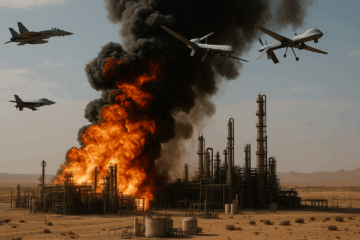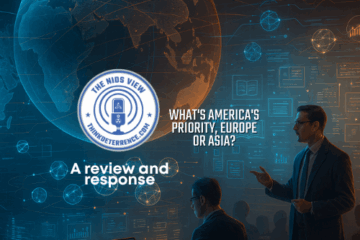America’s nuclear arms agreements with the Soviet Union and then Russia have contributed to significant reductions in nuclear arms. Despite the bilateral reduction 90 percent of the American and Russian nuclear arsenals, arms control efforts with China are going nowhere and Russia keeps thousands of theater nuclear weapons beyond the reach of arms control.
While the Cold War ended with the collapse of the Soviet empire, subsequent defense cuts and the failure to sustain and enhance the American nuclear deterrent left the United States facing the prospect of two nuclear-armed peers in Russia and China, with combined nuclear arsenals approaching some 10,000 nuclear weapons—well beyond the size and capability of the American arsenal.
Behind this reversal in nuclear arms reductions lies a set of assumptions reflected in recent American nuclear posture reviews and nuclear policy that assumed nuclear reductions and restraint would be permanent and positive. For example, the recent Congressional Commission on the Strategic Posture of the United States’ straightforward America’s Strategic Posture highlights differences in “understandings of the threats” with the Biden administration’s 2022 Nuclear Posture Review (NPR).
The 2022 NPR assumed greater cooperation between Russia, China, and the United States in addressing nuclear matters, especially preventing terror organizations and sponsoring states from acquiring nuclear weapons. Moscow, however, regularly violates arms treaties. China has never signed a bilateral nuclear arms agreement with the US.
With analysts projecting Russia and China will field approximately 10,000 theater and strategic nuclear weapons by 2035–2045, a significant reversal of events is taking place that is unavoidable. A chronological look at arms treaties from 1967–2010 reveals whether American assumptions about arms control stood the test of time, particularly with respect to the lasting import of such deals and effects on American security requirements. In that context, examining the implications of American arms control agreements is instructive.
First, the 1991 Presidential Nuclear Initiatives assumed that American restraint in nuclear forces and deployments would lead to the restrain of other nuclear powers. This assumption was incorrect.
Second, the critics of START I and II and the Intermediate Nuclear Forces Treaty (INF) assumed that the Reagan nuclear build-up would trigger a similar Soviet effort and limit any deal on nuclear weapons reductions. While Gorbachev initially increased SS-20 missile deployments, increased troops in Afghanistan, walked out of the arms talks over opposition to the Strategic Defense Initiative (SDI), and increased assistance to Cuba and Nicaragua, Reagan eventually prevailed. Peace through strength worked, contrary to the opinion of disarmament advocates.
Third, opponents of proliferation see the Non-Proliferation Treaty (NPT) as a guarantor of sharply limiting the spread of nuclear weapons, when in fact NPT members China and Russia hid their rogue behavior and facilitated the spread of nuclear programs to Pakistan and North Korea and thus consequently to Iran, Libya, Syria, and possibly Iraq.
Fourth, arms control advocates blame the United States for North Korean, Syrian, and Iranian pursuit of nuclear weapons. This blame is neither supported by facts nor a firm understanding of the security dynamics at play for each of these countries.
Fifth, because nuclear modernization often requires concomitant nuclear arms control efforts (New START ratification for nuclear modernization) to maintain support from Congress and the White House, an adversary can refuse to enter arms control agreements as a means of compromising American nuclear modernization. Constant efforts to stall modernization would leave the United States in an increasingly weak position.
Sixth, the START II process underscored Soviet efforts to kill any American ballistic missile defenses. Such efforts were supported by the arms control community. Russian President Vladimir Putin also continues to push for termination of missile defenses, which are now a central component of integrated deterrence.
Seventh, while New START achieved modest reductions from the Strategic Offensive Reduction Treaty (SORT), the pursuit of still lower numbers as part of seeking abolition or “global zero” is likely to reach a point where strategic stability fails. A world without nuclear weapons is a world once again safe for great-power conventional wars.
Eighth, the 1999 Russian Duma’s rejection of the START II arms control treaty and the ban on multiple independently targetable reentry vehicles (MIRV) is consistent with the findings of the Strategic Posture Commission, which clearly laid out Russia’s willingness to use nuclear coercion. For the arms control community, this potential use of nuclear weapons by Russia was dismissed—again proving how wrong disarmament advocates were.
For American deterrence to reflect the lessons above, it is also necessary for the United States to jettison bad thinking that still undermines deterrence effectiveness. Many arms control advocates believe conventional arms are sufficient to retaliate against an enemy’s nuclear strike, which would allow the United States to adopt a minimum deterrent of just a few hundred nuclear weapons.
A corollary to this thinking is the view that nuclear weapons are solely for deterrence, rather than warfighting. This view undermines the credibility of deterrence by undermining American seriousness in the eyes of an adversary. Absent a willingness to fight, deterrence is not credible.
Similarly detrimental to credibility is the idea that on-alert nuclear forces are destabilizing. Nothing could be further from the truth. It is the fact that nuclear forces are on-alert that makes them a less attractive target—improving deterrence credibility.
As the Strategic Posture Commission explained, China and Russia see nuclear weapons not just as a deterrent to prevent aggression, but as weapons for theater blackmail and coercion to allow aggression to succeed and keep the United States from supporting Ukraine and Taiwan.
Americans must understand that arms control efforts between the United States and adversaries is no solution for strategic stability. Arms control just for its own sake is foolish. Its utility is only in advancing American interests.
Given the current breathtaking modernization and expansion of Russia and China’s nuclear arsenals, in conjunction with their near-alliance, Americans must carefully weigh whether any arms control proposal advances American interests.
Deterrence at the strategic level remains robust since no power has the ability to launch a disarming strike. Theater-level deterrence is much weaker, with the United States at a distinct disadvantage.
For the foreseeable future, arms control has no realistic prospects. It is even difficult to argue that nonproliferation efforts are worthwhile since the United States may need the assistance of a nuclear-armed South Korea and Japan to stabilize tension in East Asia and prevent North Korean or Chinese aggression.
Instead, the United States should press forward with modernization of the strategic nuclear triad, while also looking at ways to expand theater nuclear capabilities. Rightsizing the arsenal and developing effective ballistic missile defenses are a must. Rejecting wrong-headed ideas that impede these initiatives is also necessary.
Finally, Congress must pass a defense budget on time. Over the past four decades, defense appropriations passed on time only four times. Bipartisan budget reform measures sought by the House Budget Committee will hopefully address the issue and none too soon. There is too much riding on it.
Peter Huessy is a Senior Fellow at the National Institute for Deterrence Studies, CEO of Geostrategic Analysis, and host of a forty-plus year series of seminars and symposiums on nuclear matters.
Joe Buff is a risk-mitigation actuary and former submarine technothriller author now researching modern nuclear deterrence and arms control. Views expressed by the authors in this article are their own.







Chris B: Thanks for your well considered comments! This topic intersects like a chunky Venn diagram slice with “the problem of European NATO” as discussed by Dr. Max Hoell of LLNL during this PM’s Huessy Event webinar.
n my own words, European NATO members either don’t see Russia or China as becoming severe threats to them, if only Moscow and Beijing are mollified enough — especially if said European states willingly accept the de facto bribes offered to them by Putin and Xi, in lucrative trade and essential energy deals, in exchange for turning a blind eye to aggression over Ukraine and Taiwan and elsewhere.
I suggest that we must not forget how ineffective Continental Europe was in resisting Nazi conquest despite Hitler’s very visible military buildup and violent rhetoric in the ’30s, and furthermore how little of a truly active role rubble-strewn countries like de Gaulle’s France and West Germany were able to play in building the post-War American-led world order.
While occupied by Hitler’s minions, Europe was split between resistance fighters (heroic), collaborators (despicable), and a middle ground who just desperately tried to survive — and often didn’t. This leaves terrible lasting effects on the survivors, and on their kids and grandkids, of lasting guilt feelings, deep insecurity, and difficulty sustaining healthy relationships — just ask any descendants of Holocaust survivors.
This gives an extremely different structural and historical basis to current European society compared to American that extends across generations “from then to now”, a implicit but drastic difference, in perspectives and reactions, that Americans tend to not see or understand, exacerbating America’s national weakness of endless cultural mirror-imaging.
The U.S. has been the primary producer and provider of defense and security throughout Cold War I; the Continental Europeans have been the consumers and dependents, with few notable exceptions. Breaking this cycle/linkage/feedback loop is going to be very challenging for both sides. As the French say, transslated, “The more things change, the more they stay the same.”
Finding a common vocabulary about who the adversaries really are, how dangerous they really are, and (especially) what to do about that, are going to be seriously complicated by these differences. The U.S. needs to be much more aware of what makes European countries tick qua European countries. Then we need to rediscover the common ground of national survival and security that unified us all in WWII and CWI against the deadly global perils posed by Nazi Germany, Fascist Italy, and Imperial Japan, followed by the Soviet-led Warsaw Pact — now substitute Putin-esque Russia, Xi’s China, Kims’ North Korea, and the Ayatollahs’ Iran.
Thanks to Peter and Joe for successfully debunking the fallacy of arms control in a nuclear context: For “peer competitors”, “strategic adversaries”, or “downright enemies” such as these, defaulting is the optimal behaviour, and they’ve done it consistently. Nuclear arms control thus becomes a game of gullibility at the expense of the side that plays fair: us, the good guys. Then our side gets stalled, and ends up as the biggest loser while enemies keep upgrading and expanding their nuclear arsenal and deterrence capabilities to outsmart us.
From on our own Indo-Pacific perspective, we concur with these lines: “For the foreseeable future, arms control has no realistic prospects. It is even difficult to argue that nonproliferation efforts are worthwhile since the United States may need the assistance of a nuclear-armed South Korea and Japan to stabilize tension in East Asia and prevent North Korean or Chinese aggression.” In the coming decades, the general direction of high mutual strategic mistrust will get worse before it gets better. We should steer our nuclear deterrence policies accordingly.
Furthermore, the methodology of this article can be applied to the practice of Lawfare and the reliability of any form of semi-enforceable instruments such as “codes of conduct:” whereas adversarial tactics will be to cheat our side by defaulting, in the meantime, enemies will leverage these instruments to control our side’s behaviour via stalling and inhibition, gaining strategic advantage at our expanse.